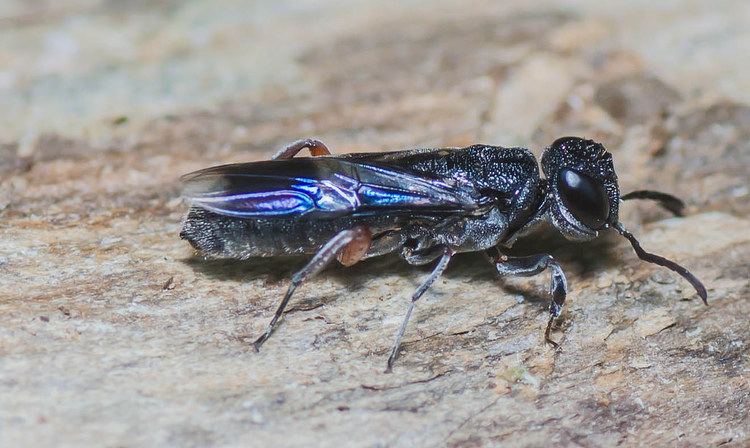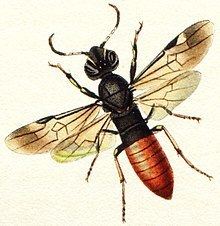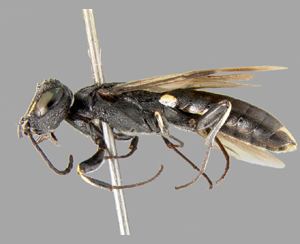Suborder "Symphyta" Scientific name Orussidae | Superfamily Orussoidea Rank Family | |
 | ||
Similar Xiphydriidae, Xyelidae, Stem sawflies, Stephanidae, Blasticotomidae | ||
The Orussidae or the parasitic wood wasps represent a small family of sawflies ("Symphyta"). Currently, about 85 extant and four fossil species are known. They take a key position in phylogenetic analyses of Hymenoptera, because they form the sister taxon of the megadiverse apocritan wasps, and the common ancestor of Orussidae + Apocrita invented parasitism for the first time in course of the evolution of the Hymenoptera.
Contents
- Biology
- Larvae
- Biology and behavior of larvae and wasps
- Systematics
- Orussidae genera and species of the World
- Orussidae of the United States Canada and Great Britain
- Fossils
- References

Biology

The fully winged wasps are 2−23 mm long. They are predominantly black but species of Chalinus, Mocsarya and Orussobaius are more or less metallic. Some species have a red thorax or abdomen and conspicuous white or golden pilosity. Many Orussus species bear white spots on the legs. The antennae of males are composed of 11, those of females of 10 articles. The modified distal antennal articles of females (article 9 enlarged, article 10 very small) are involved in vibrational sounding to detect suitable oviposition sites and the host larvae living concealed inside wood. Contrary to other "Symphyta", the antennae insert near the lower edge of the compound eyes and close to the mandible. The mandibles are orthognathous and lack evident teeth. The number of palpomeres of the maxilla and the labium varies and is used as a taxonomic character. On the wings, some cross-veins are reduced in comparison with the more complete venation of other basal Hymenoptera. Similar as in most other sawflies, the wings are held at rest with a device called "cenchri". The complete body is strongly sclerotized and bears a species-specific microstructure, which is relevant for species identification. The ovipositor is several times as long as the body, and at rest it extends inside the body from the abdomen to the prothorax, where it is coiled, and back towards the tip of the abdomen again.

Orussidae and Stephanidae are the sole Hymenoptera, in which the head bears a corona of erected teeth around the frontal ocellus. Contrary to Orussidae, the Stephanidae lack cenchri, and their mesosoma and metasoma are separated by a wasp waist, which is absent in Orussidae.
Larvae
Similar to the larvae of apocritan Hymenoptera, larvae of Orussidae have reduced some morphological features as a result of their parasitic life style inside the tunnels of wood-boring insects. They are white, subcylindrical, weakly sclerotized with a distinct head capsule. The mouthparts are hypognathous. Eyes and legs are reduced or completely absent. The mandibles are well developed and strongly sclerotized. Palps of maxilla and labium lack. The surface of the body is subdivided into distinct segments, each bearing a transverse row of 8−10 backward pointing spines.
Biology and behavior of larvae and wasps
Orussid wasps have generally been collected only seldom. Over the years, their abundance obviously is subject to strong fluctuations. The species are thermophilous and wasps are active during the hottest hours of the day. Therefore, they are rarely found by the entomologists specialized in sawflies.
Only for few species the larval biology is known. Orussidae are parasitoids of xylobiontic larvae of beetles or Hymenoptera, particularly of the larvae of jewel beetles (Buprestidae), long-horned beetles (Cerambycidae), and wood wasps (Siricidae, Xiphydriidae). Wasps can be observed running around quickly on dead tree trunks. The females locate the host larvae living concealed inside wood by generating vibrations by tapping the tips of their antennae against the wood surface. The vibrations are picked up by the modified fore legs. After locating the host, the female drills into the wood with the very long ovipositor and lays the egg. The egg is very elongate with a small expansion on the anterior end and a long expansion on the posterior end. The egg is coiled on the host. In some species the egg is possibly laid into the tunnel of the host if the host itself can not be reached, and the orussid larva itself crawls to the host. On its way to the host it may gnaw through the wood shavings left by the host. It has been disputed whether this material contributes to the nutrition of the larva. At least in Guiglia schauinslandi, the larva lives externally for its first two instars and then enters the putrid(?) liquid in the dead host, where it remains until the adult emerges.
Systematics
The suborder "Symphyta" or sawflies and woodwasps undoubtedly is a paraphyletic assemblage. The ca 9,000 species cover the ancestral hymenopteran lineages. Numerous morphological and genetic studies indicate that the Orussidae form the sister taxon of the apocritan wasps. Accordingly, parasitic life style has not evolved first in Apocrita but in the common ancestor of Orussidae + Apocrita.
Earlier, the Orussidae were sometimes put into a separate suborder, Idiogastra, but today they are classified with an own superfamily, Orussoidea. Orussidae are demonstrably monophyletic. Tribes and subfamilies within the Orussidae have been abandoned, since such earlier subdivisions could not be corroborated in phylogenetic analyses.
The cladogram is based on Schulmeister 2003. The Orussoidea are sister to the Apocrita.
Orussidae genera and species of the World
An identification key for the genera of the World was published by Vilhemsen (2003). The following list summarizes the genera and species and their gross distribution together with indications on identifikation keys:
Orussidae of the United States, Canada and Great Britain
Twelve species of Orussidae are distributed in the United States and in Canada:
In Great Britain, Orussus abietinus (Scopoli, 1763) was recorded by Stephens (1835) upon two specimens caught by William Elford Leach in Darenth Wood and Devonshire around 1817. Morice (1904) recorded a more recent specimen taken at Hastings about 1880, but after re-examination this turned out to be Xiphydria prolongata (Geoffroy, 1785) (Xiphydriidae). Benson (1951) supposed O. abietinus "to have occurred in Britain in former times."
Fossils
The extant Orussidae are believed to have originated in the Jurassic. Fossils have been reported from the Lower Jurassic of Grimmen (Lower Toarcian, Germany) and the Middle Jurassic of Daohugou (China), which display a mixture of characters associated with Orussoidea and with basal Apocrita, thus it is impossible to classify these specimens which one of these clades. Ophrynopus peritus Engel, 2008 was described from Dominican Amber, Baltorussus velteni Schedl, 2011 from Baltic Amber, Mesorussus taimyrensis Rasnitsyn, 1977 from the Late Cretaceous of Taimyr, Sibiria und Minyorussus luzzii Basibuyuk, Quicke & Rasnitsyn, 2000 from the Late Cretaceous of New Jersey.
